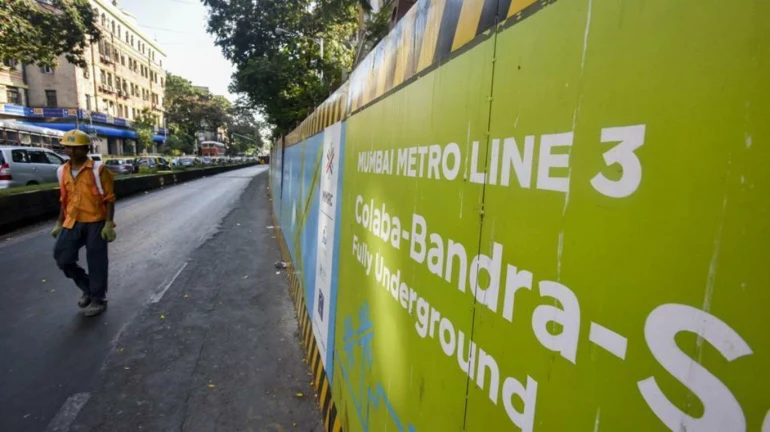
Mumbai is set to take a major leap forward in urban transportation with the partial launch of its first fully underground metro line. The Aqua Line 3, covering the stretch from Aarey to Worli Naka via Bandra Kurla Complex, has been inaugurated on Friday, May 9, 2025, by Maharashtra Chief Minister Devendra Fadnavis. However, The line will open to the public the following day, Saturday, May 10.
मुख्यमंत्री देवेंद्र फडणवीस, उपमुख्यमंत्री एकनाथ शिंदे यांच्या प्रमुख उपस्थितीत 'मुंबई मेट्रो ३ एक्वालाईनच्या टप्पा २ अ' (बीकेसी ते आचार्य अत्रे चौक)चा सेवा विस्तार होत आहे. https://t.co/YJ5EKLiBlM
— MumbaiMetro3 (@MumbaiMetro3) May 9, 2025
This 22-kilometre section of Metro Line 3 is a crucial part of the overall 33.5-kilometre corridor that will eventually connect Aarey Depot in north Mumbai to Cuffe Parade in the south. Once fully operational, the route will feature 27 underground stations, including major interchanges like Mumbai Central, Churchgate, and CSMT.
Designed to alleviate traffic congestion and improve air quality, the Aqua Line 3 is expected to significantly cut down travel times between key residential and commercial zones such as Dharavi, Dadar, Siddhivinayak, Worli, and Bandra Kurla Complex (BKC). The fully air-conditioned metro promises a more comfortable, reliable, and eco-friendly commuting alternative to the city’s overcrowded roads and trains.
Fares will start at ₹10 and go up to ₹60, keeping the service within reach for the general public. However, the metro’s connectivity is not without challenges. For instance, the Dadar station on Line 3 is nearly a kilometre away from the main railway hub, which could cause inconvenience for some commuters needing seamless transitions.
Ahead of the launch, Mumbai Metro Rail Corporation (MMRC) released images of newly completed stations such as Dadar, Worli, and Siddhivinayak. The Acharya Atre Chowk station, located in a dense commercial and residential zone, was also unveiled and praised for its engineering precision under complex urban conditions.
Here’s an exclusive first look of #Dharavi Metro Station, built using the cut-and-cover methodology along the banks of #MithiRiver. The station has successfully navigated several challenges, including land acquisition, traffic diversions, and diversion of multiple utilities… pic.twitter.com/Q4uOTRZlRT
— MumbaiMetro3 (@MumbaiMetro3) April 8, 2025
Here’s the first look at the #Dadar metro station built in the heart of Mumbai’s busiest hub. From shifting shops and utilities to working through festivals and the pandemic, this station is a story of precision, patience, and persistence beneath the surface.#MumbaiUnderground… pic.twitter.com/ALxF3NRcgn
— MumbaiMetro3 (@MumbaiMetro3) April 12, 2025
Here's an exclusive glimpse of #𝙎𝙞𝙙𝙙𝙝𝙞𝙫𝙞𝙣𝙖𝙮𝙖𝙠 metro station built near one of #Mumbai’s most revered temples, where devotion meets engineering. Navigating tight spaces and constant crowds, the station was constructed with extra care and coordination. Today, it brings… pic.twitter.com/y1wedtYOXV
— MumbaiMetro3 (@MumbaiMetro3) April 14, 2025
#Worli is finally making its debut on the rail map with the #Aqualine, bringing seamless metro connectivity to this vital part of Mumbai for the very first time.
— MumbaiMetro3 (@MumbaiMetro3) April 18, 2025
Residents and commuters can now enjoy smoother, quicker, and more convenient travel every day.#AquaLine… pic.twitter.com/r1n17utVMH
Here’s the first look at the #𝘼𝙘𝙝𝙖𝙧𝙮𝙖𝘼𝙩𝙧𝙚𝘾𝙝𝙤𝙬𝙠 metro station constructed amidst relentless traffic, giant utility lines, and the heartbeat of Mumbai’s commercial and residential zones. It’s where precision met planning to make space underground, without pausing… pic.twitter.com/GDmDPUnPu8
— MumbaiMetro3 (@MumbaiMetro3) April 20, 2025
The stations feature modern amenities, including Automatic Fare Collection (AFC) gates, elevators, wide staircases, and well-lit interiors aimed at enhancing commuter comfort and accessibility for all users, including the elderly and people with disabilities.
With the introduction of Aqua Line 3, Mumbai moves closer to its vision of a modern, integrated public transport system. As future phases are completed, the line is poised to become a key component of the city’s transit infrastructure.





